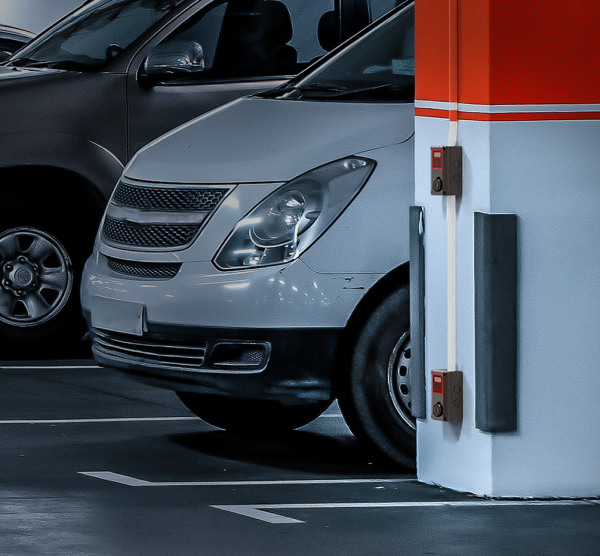Gas Sensor Mounting Heights | ACI

Where to Mount your Sensors? Gravity is Undefeated!
When a small stone is dropped into a lake, why does it sink? Alternatively, why does a kayak float when the stone doesn’t? It’s obviously not the object’s weight–a loaded kayak weighs more than the stone. Spoiler alert–it’s the object’s density. Learn more about how this applies to gas sensor mounting below.
Gas sensor applications have been growing in recent years and are expected to continue to grow for the foreseeable future. Parking garages, vehicle repair and storage facilities, fire stations, and bus barns are common places that call for carbon monoxide (CO) and nitrogen dioxide (NO2) gas sensing.
Sensor manufacturers provide guidelines for sensor mounting height, particularly for NO2 gas detection. These recommendations vary among manufacturers, suggesting different mounting positions based on different theories.
One approach advises mounting the sensor at the highest possible position. The rationale behind this is that vehicle exhaust is typically hot, causing the gas to rise. By placing the sensor high up, it can detect the gas early and trigger the necessary exhaust sequence before it reaches breathing height.
Another perspective suggests mounting the sensor at breathing height. The reasoning here is that people are typically present at this height, so it makes sense to detect the gas where individuals are located.
In contrast, some manufacturers advocate for mounting the sensor as low as possible. This recommendation stems from the understanding that the chemical density of NO2 gas is higher than that of ambient air. By placing the sensor at a lower position, it can effectively capture the denser gas particles.
Let's now examine each of these NO2 sensor mounting options individually:

High Mounting
It is true that vehicle exhaust is hot and that temperature affects the density of gases. NO2 is less dense the hotter it gets, but it cools very quickly when mixed with ambient air (typically in less than 5 minutes). As such, NO2 gas may cool before it gets to the ceiling, and any NO2 sensor mounted high may never get the opportunity to detect the gas.
Note: There are some NO2 applications, specifically for vehicles with stack exhaust that pushes the exhaust fumes immediately upward to the ceiling, where mounting NO2 sensors as high as possible can be effective.
Breathing Height
At first glance this option makes sense. It’s reasonable to think: “Most people are between 5-6 feet tall, breathing air that’s 5-6 feet from the floor, so that’s where we should mount the NO2 sensor.” But upon further analysis, mounting NO2 sensors at breathing height can be challenging because children and people in wheelchairs are breathing at < 5 feet from the floor, and vehicle repair/maintenance technicians are frequently on the floor or under vehicles.
Because NO2 gas rises when hot and then falls when cooled, measuring NO2 gas at 5-6 feet from the floor is equivalent to catching a falling knife.
Low Mounting
The density of ambient air is approx. 1.275 kilograms per square meter (kg/m3) at 0 C. The density of NO2 gas is approx. 3.663 kg/m3 at 0 C–nearly three times as dense as ambient air. In every scenario and every application, NO2 gas will sink to the floor of the building.
Temperature changes, vehicle movement, wind, and ventilation will cause the air (and all the gases therein) to move, but like the stone in the lake mentioned above, NO2 gas will always find its way to the floor. As such, the best practice is to mount NO2 sensors as close to the floor as possible.
The force of gravity is an undeniable reality. This fact became painfully evident to me when I had a fall from a ladder. It applies not only to unfortunate home improvement mishaps but also to gas sensor applications. ACI gas sensors are meticulously designed to deliver accurate and reliable readings of toxic or combustible gases. Their installation locations are strategically determined based on the areas where the respective gases are most likely to be present. Consequently, the recommended mounting heights are dictated by the density of the gas being measured. Even the most precise, cost-effective, and aesthetically pleasing sensor becomes worthless if it is installed in the wrong location.

While it may be tempting to mount all gas sensors at a single height or consolidate multiple sensors within a single enclosure, it's important to consider the implications when dealing with toxic gases that pose a threat to occupants. Is it truly wise to defy gravity in such situations? What may seem convenient for the installer may not necessarily be the best approach for the safety and well-being of those present. Considering the highly toxic nature of NO2 gas, particularly at low concentrations, it becomes crucial to exhaust and eliminate as much of it as possible.
Learn More About ACI Recommended Mounting Heights Here or Check Out their Blog Post Here

